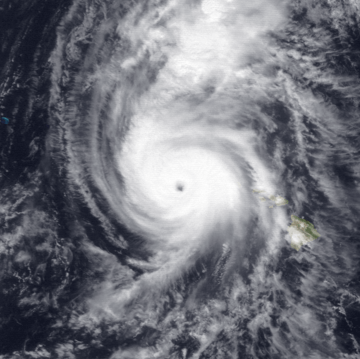Hurricane Iniki facts for kids
| Category 4 major hurricane (SSHWS/NWS) | |

Hurricane Iniki at peak intensity just south of KauaʻI on September 11, 1992
|
|
| Formed | September 5, 1992 |
|---|---|
| Dissipated | September 13, 1992 |
| Highest winds | 1-minute sustained: 140 mph (220 km/h) |
| Lowest pressure | 938 mbar (hPa); 27.7 inHg |
| Fatalities | 6 direct |
| Damage | $1.8 billion (1992 USD) |
| Areas affected | Hawaiʻi (particularly Kauaʻi) |
| Part of the 1992 Pacific hurricane season | |
Hurricane Iniki was a very powerful storm that hit Hawaii in 1992. It was the 10th hurricane and the 7th major hurricane of the 1992 Pacific hurricane season. Iniki struck Hawaii just a few weeks after Hurricane Andrew caused a lot of damage in Florida.
Contents
How Hurricane Iniki Formed and Grew
Hurricane Iniki likely started as a tropical wave (a low-pressure area) that moved off the coast of Africa on August 18. This wave traveled west across the Atlantic Ocean. It then crossed Central America and reached the Pacific Ocean on August 28.
The weather conditions slowly became better for the storm to grow. On September 5, the wave became a tropical depression. This means it was a swirling system of thunderstorms. It was located about 1,700 miles (2,700 km) southwest of Cabo San Lucas, Mexico.
The depression continued moving quickly to the west. On September 8, it slowed down and became a tropical storm. This meant its winds were getting stronger. Iniki kept getting more powerful and officially became a hurricane on September 9.
The storm then turned north, heading towards Hawaii. The next day, it became a major hurricane. On September 11, Iniki reached its strongest point as a Category 4 hurricane. It hit Hawaii with very strong winds of 145 miles per hour (233 km/h). After hitting Hawaii, Hurricane Iniki quickly lost its strength and changed into a non-tropical storm.
Preparing for the Storm and Its Effects
The Central Pacific Hurricane Center (CPHC) is the group that warns people about hurricanes in the central Pacific. At first, they did not give warnings for Iniki very early. For several days, the CPHC and news reports thought Iniki would stay far south of Hawaii. They only expected some big waves.
However, some computer models showed the hurricane might turn north towards the islands. But the CPHC forecasters did not believe these models. It was not until the evening of September 10, less than 24 hours before the storm hit, that a warning was finally given to the public.
Warnings and Evacuations on Kauaʻi
A hurricane watch was issued for Kauaʻi early on September 11. This means a hurricane was possible. Later that day, it was upgraded to a hurricane warning, meaning a hurricane was expected. Before Iniki arrived, about 8,000 people went to shelters. Many of them remembered Hurricane Iwa, which hit 10 years earlier.
Some large hotels kept their guests inside the buildings during the storm. Many residents left the island days before to stay with family or friends, or to go to shelters. Because schools were closed, traffic was light. This helped people evacuate smoothly.
Evacuations on Oʻahu
The CPHC also issued a tropical storm warning for Oʻahu on September 11. This was later changed to a hurricane warning. Even though Oʻahu was not directly hit, Iniki's large winds caused nearly 30,000 people to go to 110 public shelters.
Public school buildings were used as shelters. They were only for safety and did not provide food, beds, blankets, or medicine. About one-third of Oʻahu's population evacuated. Many others went to stay with family or friends.
The evacuations went well, starting with areas near the coast. Vans and buses helped people who needed transportation. Police officers helped manage traffic at busy intersections. The main problems during the evacuation were not enough parking at shelters and limited exit routes from coastal areas.
Damage Caused by Iniki
Hurricane Iniki was the most expensive hurricane to ever hit Hawaii. It caused about $1.8 billion in damage. This would be about $2.6 billion in 2004 money. Most of the damage was on the island of Kauaʻi. Thousands of homes were destroyed there, and a large part of the island lost electricity. Oʻahu also had significant damage. Sadly, Iniki also caused six deaths.
The hurricane almost hit the Central Pacific Hurricane Center in Honolulu. If it had, Iniki, along with Hurricane Andrew and Typhoon Omar, would have hit all three main weather offices responsible for hurricane warnings within two months.
Images for kids
-
Iniki (left) as a newly formed tropical storm next to Hurricane Orlene, on September 8
-
Storm surge from Iniki
See also
 In Spanish: Huracán Iniki para niños
In Spanish: Huracán Iniki para niños





